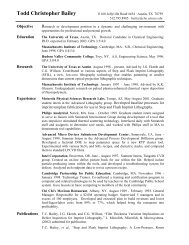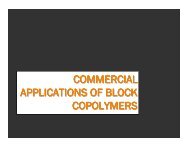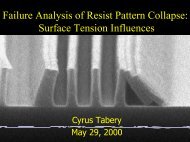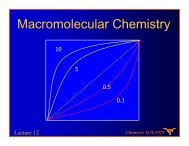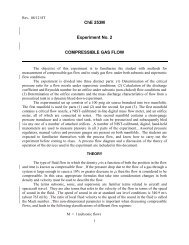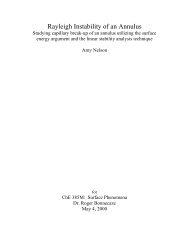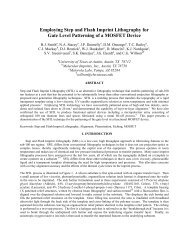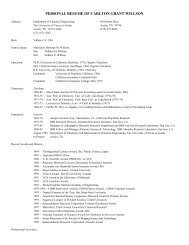Vapor Phase Osmometry
Vapor Phase Osmometry
Vapor Phase Osmometry
You also want an ePaper? Increase the reach of your titles
YUMPU automatically turns print PDFs into web optimized ePapers that Google loves.
<strong>Vapor</strong> <strong>Phase</strong> <strong>Osmometry</strong>For determination of the Number Average Molecular Weight of a Polymer SampleLinda PassanitiCHE 392NFebruary 5, 2009
Outline• Introduction & Fundamentals• Equations• Instrument & Experiment• Conclusion
Introduction & Fundamentals• A relative technique used to determine the NumberAverage Molecular Weight (Mn) of a polymer in adilute polymer solution• Most common methods for measuring Mn areMembrane <strong>Osmometry</strong> and <strong>Vapor</strong> <strong>Phase</strong><strong>Osmometry</strong>• Used for polymers with molecular weights in therange of 250 to 100,000
Introduction & Fundamentals• <strong>Vapor</strong> <strong>Phase</strong> <strong>Osmometry</strong> isbased on the equilibriumthermodynamics of vaporpressure• <strong>Vapor</strong> Pressure is acolligative propertyEvaporation in a Closed Container
Introduction & Fundamentals• The determination of Mn operates on the principle that the vaporpressure of a solution is lower than that of the pure solvent at thesame temperature and pressure• Magnitude of the vapor pressure decrease is directly proportionalto the molar concentration of solute• Does not directly measure vapor pressure but measures change involtage which is proportional to change in temperature
• At equilibrium:EquationsAltering the chemical potential of a solvent by dissolving a non-volatilesubstance in it alters the colligative properties of the solvent(1)• Upon adjustment to new equilibrium:• Where:(2)
Equations• The total differential of the chemical potential:(3)(4)• Where:
Equations(5)(6)
Equations• Substituting equations from (6) into (5):(7)• Where:• Integrating (7):(8)
Equations• And:• Where:• Rearranging # will yield an equation of temperaturein terms of the number of dissolved solute particles:(9)
Instrument & Experiment•The wick provides a vapor saturatedatmosphere•Syringes used to inject standard andsample•Thermistors detect changes intemperature•Voltage changes are recorded•System at an equilibratedtemperature
Instrument & Experiment• Calibration withstandards is necessary– Must have VP no morethan 0.1% of that of thesolvent– High Solubility• Common solvents are:– Sucrose octaacetate fororganic solution– Simple sucrose foraqueous solutionCalibration CurveBest fit line extrapolated to zero
Instrument & Experiment• Calibration is necessary to determine the CalibrationFactor, K• Where:• Molecular weight determine by:
Instrument & ExperimentSample DataCharacteristic Data of Solvents and PolymersCalibration constants, K (Volt g/mol)
Instrument & Experiment
Conclusion• Advantages of VPO include:– Speed• Isothermal distallation & Ebullioscopy are slow– Accuracy• Cryoscopy has typical standard deviation of ~10%– Small amount of sample required• Ebullioscopy requires relatively large amount of sample– Useful for a wide range of temperatures• Cryoscopy & Ebullioscopy less flexible
Conclusion• Disadvantages of VPO include:– Requires calibration• Membrame <strong>Osmometry</strong> does not– Molecular weight constraints• Questions?
References1. <strong>Vapor</strong> Pressure Osmometer. 22 Jan.2009.http://www.chem.ufl.edu/~polymer/instrumentation/vpo.html2. <strong>Vapor</strong> Pressure Osmometer. 25 Jan. 2009.http://www.pci.uzh.ch/e/documents/Dampfdruck_Osmometrie.pdf3. Hiemenz, Paul C., and Timothy P. Lodge. Polymer Chemistry. 2 nd Ed. NewYork: CRC Press,2007.4. Wiley, John. Characterization and Analysis of Polymers. New Jersey: JohnWiley & Sons, Inc., 2008. Google Book Search. 28 Jan. 2009 .5. http://www.materials.uoi.gr/polymers/assets/pics/lab%20pics/vpo_osmometer.JPG6. Karimi, M., et al. “Determination of Solvent/Polymer InteractionParameter of Moderately Concentrated Polymer Solutions by <strong>Vapor</strong>Pressure <strong>Osmometry</strong>.” Polymer 2008.03.036. 29 Feb. 2009http://www.sciencedirect.com.ezproxy.lib.utexas.edu/science



